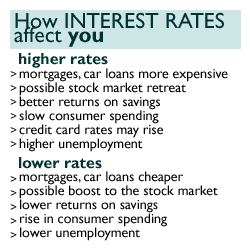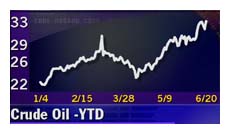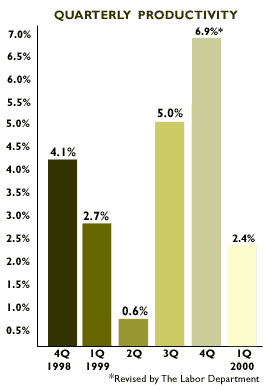|
Toning it down, Fed style
|
 |
June 26, 2000: 1:16 p.m. ET
The goal is to avoid inflation, but does the party have to end in the process?
By Staff Writer M. Corey Goldman
|
NEW YORK (CNNfn) - Times certainly are good. Help wanted signs abound. People have jobs. Stock markets are once again producing returns. Prices are relatively stable. And folks are out there spending money -- on clothes, homes, cars, vacations and many of life's oft-considered frivolous perks.
 But if the gurus at the Federal Reserve have their way, they'll ultimately take away the punch bowl and cajole us into replacing the caviar with tuna fish and the Dom Perignon with Chianti. No more good times for you, their actions seem to say. Excesses are bad. This party has come to an end. But if the gurus at the Federal Reserve have their way, they'll ultimately take away the punch bowl and cajole us into replacing the caviar with tuna fish and the Dom Perignon with Chianti. No more good times for you, their actions seem to say. Excesses are bad. This party has come to an end.
Now why would anybody want to do that?
After more than nine years of uninterrupted economic expansion, more than four years of four-percent-plus growth, more than two years of month-over-month double-digit job gains and a decade that triumphed the U.S. as the No. 1 technology and software producer, why would the Fed want to reign it in?
"It is very difficult to explain sometimes why it is important to keep things in moderation, why it is crucial for the Fed to be vigilant against inflation," said Charles Lieberman, chief economist with First Institutional Securities. "What people have to remember is that the economy cannot grow in excess forever without causing problems, without stirring inflation and other issues."
Throwback from the '30s
Ensuring that prices remain stable has been an obsession for the central bank since the roaring '20s prompted a surge in inflation, ushering in the Great Depression of the 1930s. In its simplest form, prices that rise at an equal or faster rate than what people earn for a living or have in savings makes their dollars go a shorter distance, reducing their spending power and hurting the overall economy.
It was an obvious issue, too, in the 1970s, when oil shortages led to surging gasoline prices, and eventually double-digit readings on inflation.
 In that vein, keeping inflation restrained has been what Fed Chairman Greenspan's recent campaign to raise short-term rates has been all about, even with little evidence that it's a problem. The Fed began its rate-increase binge a year ago, and has raised its benchmark target rate by almost 2 percent, even with very little evidence other than oil and gasoline that prices are on the rise. In that vein, keeping inflation restrained has been what Fed Chairman Greenspan's recent campaign to raise short-term rates has been all about, even with little evidence that it's a problem. The Fed began its rate-increase binge a year ago, and has raised its benchmark target rate by almost 2 percent, even with very little evidence other than oil and gasoline that prices are on the rise.
But it's not inflation itself that is the problem; it's the potential for inflation that Wall Street analysts and Fed officials are worried about. On a year-over-year basis, consumer prices as measured by the Labor Department rose at a seasonally adjusted 3.6 percent pace, up from 2.7 percent for all of 1999. And with oil prices and gasoline prices on the rise, overall inflation is expected to creep even higher in the months ahead.
To offset that, the Fed is implementing short-term pain for long-term gain -- an easy concept for Wall Street, but a somewhat difficult one for Main Street, where folks are dishing out more for the mortgage and car payments than they were a year ago thanks to the Fed's six rate increases in the past year.
Keeping it under control
"It's not that the Fed is trying to break up the party, it's that they're trying to keep it under control so there's enough to go around for everyone," said Warren Bailey, an economics professor with Cornell University. "Inflation is a signal that we are running out of some kind of resource."
 The most obvious resource of late seems to be oil. Even with OPEC's announcement last week to boost crude oil production, most analysts don't expect prices at the pumps to head much lower this summer -- something that very quickly and very obviously makes a big dent in consumers' wallets. The most obvious resource of late seems to be oil. Even with OPEC's announcement last week to boost crude oil production, most analysts don't expect prices at the pumps to head much lower this summer -- something that very quickly and very obviously makes a big dent in consumers' wallets.
That has already filtered its way into the consumer price index and is expected to push it even higher through the latter half of the year, according to economists' predictions. Energy prices have risen almost 15 percent in the 12 months ended in May; prices gained almost 4 percent last month alone.
"It took ten years to really correct the inventory excesses in the oil industry, and now we are unfortunately paying the piper," said Dan Veru, a portfolio manager with Palisade Capital Management. "Think of a whole generation of car owners who now own much less fuel efficient automobiles with SUV's. Consumption is up considerably and that trend is not going to reverse itself."
Productivity: our friend
To be sure, there is lots of evidence out there that prices remain in check. Ford Motor Co. (F: Research, Estimates), for instance, announced last week that it plans to hold the brakes on all prices for its 2001 model-year vehicles -- an unprecedented move in light of the fact that its sales are at records.
The reason Ford is able to do that is because of productivity, where technological advancements including faster assembly, just-in-time delivery and the exchange of parts and other information through the Web, have allowed the auto maker to keep its costs, and therefore prices, contained.
 "Only a few years ago, auto sales numbers like those seen recently would have automatically lead to expectations of higher prices," said Ian Shepherdson, chief U.S. economist with High Frequency Economics. "Now, increasing transparency in car prices, substantially due to the Internet, together with the automakers' ability to hold down unit labor costs, means that stronger sales do not necessarily lead to higher prices." "Only a few years ago, auto sales numbers like those seen recently would have automatically lead to expectations of higher prices," said Ian Shepherdson, chief U.S. economist with High Frequency Economics. "Now, increasing transparency in car prices, substantially due to the Internet, together with the automakers' ability to hold down unit labor costs, means that stronger sales do not necessarily lead to higher prices."
Patricia Chadwick, President of Ravengate Partners, told CNNfn's Market Call that productivity gains will likely help companies post stronger-than-anticipated second-quarter profits -- something she wasn't expecting to see after the Fed's rate increases. Still, the economy will slow down in the second half of the year, slowing profits with it. (438KB WAV) (438KB AIFF)
So no inflation, right? Companies are able to keep their prices steady or even lower them because they can produce stuff better, faster and cheaper?
A marathon, not a rat race
Not so fast, according to economists. Productivity gains such as the ones Ford is using to keep its prices in check are typically strong when the economy is growing. Productivity rose at an unrevised annual rate of 2.4 percent in the first three months of 2000 from the fourth quarter of 1999.
But it doesn't always work that way. For one, if companies find it difficult to find workers, then output can only rise by so much. For instance, if Ford has trouble finding the assembly workers it needs to boost production, then it may not be able to meet demand for the cars it makes. That ultimately lowers productivity and drives up prices, as consumers become willing to pay more.
 On the other hand, productivity gains typically falter as the economy slows. That's because, as companies scale back production, they need fewer workers, leading to less output and less productivity. That too can lead to lower productivity and higher prices -- more concern for Fed officials. On the other hand, productivity gains typically falter as the economy slows. That's because, as companies scale back production, they need fewer workers, leading to less output and less productivity. That too can lead to lower productivity and higher prices -- more concern for Fed officials.
"Productivity always slows as the economy slows," said Wayne Ayers, chief economist with FleetBoston. "If labor and wage costs are still on the rise and productivity slows, either corporate profits decline or prices increase."
And that's what the Fed is trying to avoid by raising interest rates. The idea behind it is that consumers and businesses, by paying more in borrowing costs, will cut back their spending, put more away in savings and keep the overall economy on a more even keel.
"Do they really want to end the party? Of course not," said Michael Gregory, a senior economist with Lehman Brothers. "They want to tone the party down before something gets broken or damaged, or worse, before someone gets hurt. It's similar to a marathon: if you pace yourself properly you can get to the end without overexertion. That is what the Fed is trying to do here." 
|
|
|
|
|
 |

|

